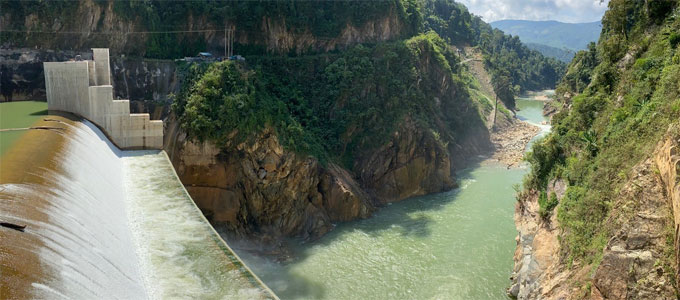Nam Pha Gnai hydropower plant, Laos

Client: DSK Group
Location: Laos
Date: 2014–2019
Optimising a hydropower project for efficient, cost-effective construction
Background
With high annual rainfall, hilly terrain and the ability to export electricity to neighbouring countries, Laos has the potential to become the hydropower ‘battery of South-East Asia’.
Located in the Nam Ngum river basin at the convergence of the Nam Ngum, Nam Pha Noi and Nam Pha Gnai rivers, the 19.2 MW run-of-river Nam Pha Gnai hydropower project comprises a 70m-high concrete gravity dam, 1.2km-long headrace tunnel, 5.1km-long channel, forebay, 280m-long surface penstock to feed three Francis turbines (2 x 7.4 MW + 1 x 4.4 MW) housed in a surface powerhouse.
Solution
Entura was awarded contracts for Owner’s Engineer services and the detailed engineering in 2014. Although the layout of the project had already been approved, we were able to optimise individual project components during detailed design.
We achieved a significant reduction in the quantity of concrete required by considering a range of options, which were further verified through finite element analysis. These options included giving the dam an arch profile, sloping the foundation level upstream, and providing a cantilever crest upstream. Rather than using a conventional gate structure and arrangement, operation of the intake service gate and emergency gate was proposed through a circular shaft of 6.5 m diameter with minimum 6 m rock ledge on the upstream face.
Another challenge was the very great height (up to 120 m) of excavation in the headwork area. To keep the excavation slope stable, we analysed it using Phase-2 software and recommended a support system based on the analysis. The excavation slopes were found to be stable even after two years of hill cutting.
By recommending a revision in the proposed layout of the approach road and canal (from being on the same level to being on different levels), we also reduced the excavation quantity by approximately 65%.
The initial study had found that canals would need to cross streams at 13 locations. We recommended using concrete pipes (cast in situ) rather than bridges, which reduced costs by around 40%.
In another optimisation, we relocated the powerhouse to decrease the rock excavation and the length of the tailrace.
Outcome
The Nam Pha Gnai hydropower plant was successfully commissioned late in 2019. Not only did our team add value beyond the contract by supporting the client with contract negotiations, we also ensured smooth progress of construction by optimising machinery and labour usage in the civil and hydro-mechanical works, and optimised project components to achieve significant cost savings.
In all our work on this project, protecting the natural environment, avoiding adverse social impacts, and ensuring sustainability into the future were high priorities.


